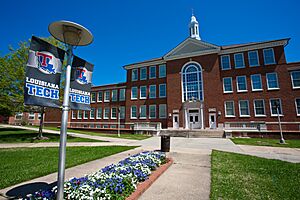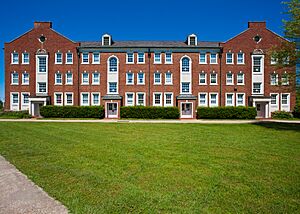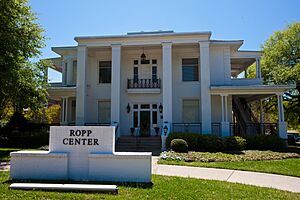History of Louisiana Tech University facts for kids
The History of Louisiana Tech University began in 1894 when it was founded as the Industrial Institute and College of Louisiana in Ruston, Louisiana. The main goal was to help grow new industries in Louisiana. Just four years later, in 1898, the school changed its name to the Louisiana Industrial Institute.
Later, in 1921, it became the Louisiana Polytechnic Institute. This new name showed that the school had grown from a trade school into a bigger technical institute. Even though people called it Louisiana Tech for about 50 years, it officially became Louisiana Tech University in 1970. Over time, the school grew from a small institute with one building to a large university with five colleges and about 11,800 students.
Contents
Starting the University
After the Reconstruction period ended in Louisiana in 1877, there were only two major universities: Tulane University and Louisiana State University (LSU). Some smaller colleges existed in northern Louisiana. The state government then started to support creating more colleges across Louisiana, like Southern University in 1880 and Louisiana State Normal School in 1884.
On May 14, 1894, a year after a fire destroyed the old Ruston College, local leaders in Lincoln Parish decided to create an industrial institute. They asked their State Representative, George M. Lomax, to introduce a bill. On July 6, 1894, the state government passed a law to create The Industrial Institute and College of Louisiana in Ruston.
The school was meant to teach "white children of the State of Louisiana in the arts and sciences." Some of the first skills taught included telegraphy (sending messages), stenography (shorthand writing), drawing, needlework, and bookkeeping. Since it was the only state college north of Natchitoches, it was easy to get in. Students for the main class needed to be at least 14 years old and able to read, write, and spell fairly well.
The Industrial Institute and College of Louisiana chose Colonel Arthur T. Prescott as its first president in 1894. Colonel Prescott helped get $20,000 from the state, Lincoln Parish, and the City of Ruston. He also got 20 acres of land donated by Francis P. Stubbs. Prescott then led the building of the first structures on campus.
The first building, called The Old Main Building, was a two-story brick building. It had eight classrooms, an auditorium, a chemistry lab, and two offices. Prescott also set up a reading room with 125 books from his own collection, which became the school's first library. Another building was made for teaching mechanics. In 1898, Hale Hall was built as a dormitory for girls.
During Colonel Prescott's five years, the school grew, and the first diplomas were given out. On September 23, 1895, the first classes began with six teachers and 212 students from 22 parishes. Students wanted music classes, so the school started offering piano, voice, and violin. By 1897–1898, there were 300 students and 12 teachers.
In the spring of 1897, Harry Howard received the school's first degree, a Bachelor of Industry, after two years of study. Mr. Howard later became a teacher and treasurer at the college for over 25 years. The first graduation ceremony was held in 1898, where ten students received their diplomas.
Louisiana Industrial Institute (1898–1921)
In 1898, Louisiana passed a new state constitution. This constitution changed the school's name from "The Industrial Institute and College of Louisiana" to the Louisiana Industrial Institute. The next year, Colonel Prescott left to teach at LSU. W. C. Robinson, one of the first teachers from 1894, became the new president in 1899.
In its early years, the Louisiana Industrial Institute faced challenges. It didn't get enough money from the state government, and teachers' salaries were low. This led to many changes in teachers and presidents. From 1899 to 1907, the school had four presidents, and only one, James B. Aswell, stayed longer than two years.
In 1900, the school changed its courses. Students first did two years of basic studies, then three years of college-level courses. They could choose business, mechanics, or home science. High school graduates could skip the first two years. By 1905, the minimum age for new students was raised. Girls had to be at least 15, and boys at least 16 for the first year. By 1909, all young men needed to be at least 16 to get in.
Student life grew as enrollment reached over 800 students in 1904–1905. About 250 girls lived in Hale Hall, and 125 boys lived in Boys' Hall. Students formed four literary societies for English studies. The Young Men's Christian Association and the King's Daughters were Christian groups on campus. Students and teachers gathered for Bible reading and prayer before school each day. Students were also required to attend church on Sundays. The school also had football and baseball teams. In 1905, the first school yearbook, The Lagniappe, was published.
The Mechanic Arts Building was built in 1904 because the Mechanical Arts Department was growing fast. This building housed the Mechanical Arts Department and the School of Engineering until 1940. The Ropp Center, built in 1911, was the original President's home and is the oldest building still on campus. It's an Italian-style, wood-frame building and was home to Louisiana Tech's presidents for almost 60 years.
In the late 1910s, the Louisiana Industrial Institute started to change its degree programs, including engineering. As a result, they began offering bachelor's degrees in engineering, business administration, education, and home economics. In 1919, the school started granting a standard bachelor's degree. On June 15, 1921, the first bachelor's degree in General Engineering was awarded.
Change to the Louisiana Polytechnic Institute (1921)
Quick facts for kids |
|
|
Bogard Hall, Louisiana Tech University
|
|
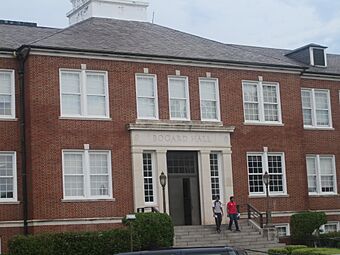 |
|
| Location | 600 Dan Reneau Drive, Ruston, Louisiana |
|---|---|
| Area | 4 acres (1.6 ha) |
| Built | 1939 |
| Built by | T.L. James |
| Architect | Neild, Somdal & Neild |
| Architectural style | Colonial Revival |
| MPS | The 1930s Building Boom at Louisiana Tech MRA |
| NRHP reference No. | 98000119 |
| Added to NRHP | February 20, 1998 |
|
Howard Auditorium, Louisiana Tech University
|
|
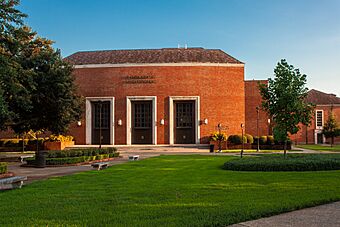 |
|
| Location | Corner of Adams Boulevard and Dan Reneau Drive, Ruston, Louisiana |
|---|---|
| Area | 4 acres (1.6 ha) |
| Built | 1939-40 |
| Built by | Nathan Wohlfeld |
| Architect | Neild, Somdal & Neild |
| Architectural style | Moderne |
| MPS | The 1930s Building Boom at Louisiana Tech MRA |
| NRHP reference No. | 98000113 |
| Added to NRHP | February 20, 1998 |
|
Keeny Hall, Louisiana Tech University
|
|
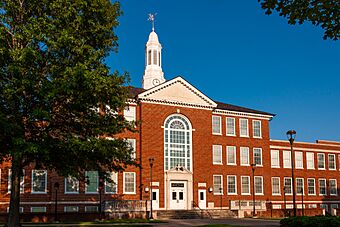 |
|
| Location | Keeny Circle, Ruston, Louisiana |
|---|---|
| Area | 6.5 acres (2.6 ha) |
| Built | 1936 |
| Built by | Caldwell Brothers and Hart |
| Architect | Weiss, Dreyfous and Seiferth; Neild, Somdal & Neild |
| Architectural style | Colonial Revival |
| MPS | The 1930s Building Boom at Louisiana Tech MRA |
| NRHP reference No. | 98000114 |
| Added to NRHP | February 20, 1998 |
|
Prescott Memorial Library, Louisiana Tech University
|
|
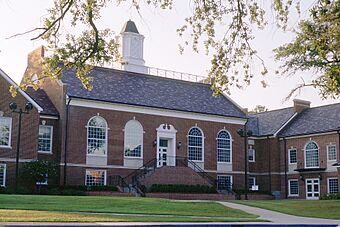
Old Prescott Memorial Library,
now University Hall |
|
| Location | Keeny Circle, Ruston, Louisiana |
|---|---|
| Area | less than one acre |
| Built | 1926 |
| Architect | Neild, Somdal & Neild |
| Architectural style | Colonial Revival |
| MPS | The 1930s Building Boom at Louisiana Tech MRA |
| NRHP reference No. | 98000116 |
| Added to NRHP | February 20, 1998 |
|
Reese Agriculture Building, Louisiana Tech University
|
|
| Location | Reese Drive, Ruston, Louisiana |
|---|---|
| Area | less than one acre |
| Built | 1939-40 |
| Built by | C. E. Andrews |
| Architect | Neild, Somdal & Neild |
| MPS | The 1930s Building Boom at Louisiana Tech MRA |
| NRHP reference No. | 98000118 |
| Added to NRHP | February 20, 1998 |
|
Robinson Hall, Louisiana Tech University
|
|
 |
|
| Location | Madison Avenue, Ruston, Louisiana |
|---|---|
| Area | less than one acre |
| Built | 1939 |
| Built by | T.L. James |
| Architect | Neild, Somdal & Neild |
| Architectural style | Colonial Revival |
| MPS | The 1930s Building Boom at Louisiana Tech MRA |
| NRHP reference No. | 98000117 |
| Added to NRHP | February 20, 1998 |
|
Toliver Dining Hall, Louisiana Tech University
|
|
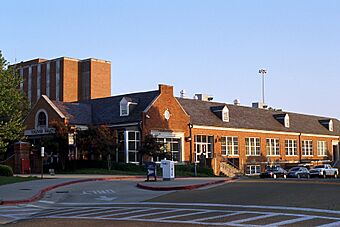 |
|
| Location | Wisteria Street, Ruston, Louisiana |
|---|---|
| Area | less than one acre |
| Built | 1939 |
| Architect | Neild, Somdal & Neild |
| Architectural style | Colonial Revival |
| MPS | The 1930s Building Boom at Louisiana Tech MRA |
| NRHP reference No. | 98000115 |
| Added to NRHP | February 20, 1998 |
On June 18, 1921, Louisiana adopted another new constitution. This changed the school's name again, from the Louisiana Industrial Institute to Louisiana Polytechnic Institute. After this name change, the school continued to organize its courses. In 1926, Louisiana Polytechnic Institute's courses were grouped into three main areas: The School of Education, The School of Engineering, and the School of Liberal Arts and Sciences.
Growing Pains
By the mid-1930s, the institute was growing very fast. Student numbers increased by almost 60% from 1933 to 1937. However, the money from the state only went up by 17% during the same time. The dorms and dining hall couldn't handle all the students. Things were so difficult that in 1937, the school's accrediting agency put it on probation. They pointed out too many students per teacher, crowded classrooms, and a library that wasn't good enough. The school also had to turn away male students from the agriculture department because there weren't enough farm facilities.
Because of these problems, students and President Edwin Richardson asked the state government for more money to build new facilities on campus.
The first big building project was a new administration building. This was needed because on January 6, 1936, a fire completely destroyed the Old Main Building, which had been the school's first building and administrative office. The new building was finished in 1937 and first named after the governor at the time. Around 1940, it was renamed Keeny Hall to honor John Keeny, a former president of the school who had passed away.
Building Boom of 1939–1940
Even with Keeny Hall finished in 1937, Louisiana Polytechnic Institute still had problems fitting its growing student body on campus. For years, the school asked the state government for more money. School officials also sought help from the Federal Government through New Deal funds. The school first wanted to build 20 new buildings, which would have doubled the number of buildings on campus. While this big plan was scaled back, many important buildings were approved, with about $2,000,000 used for six new campus buildings.
The new buildings constructed between 1938 and 1940 were:
- Howard Auditorium: A large auditorium with 3,000 seats and classrooms, named after Tech's first graduate, Harry Howard.
- Bogard Hall: A big three-story building for the School of Engineering, the first expansion for engineering since 1905.
- Robinson Hall: A dormitory for men.
- Tolliver Hall (also known as Toliver Dining Hall): A large dining hall designed to serve 800 students, much bigger than the old one that only seated 250.
- Reese Hall (also known as Reese Agriculture Building): A two-story classroom and lab building for the agriculture school.
- Aswell Hall: A dormitory for women.
Most of these new buildings were built in the center of the old campus in the Colonial Revival style. Reese Hall was built on the Tech Farm campus, and Howard Auditorium was a more modern style.
In 1936, the Student Government Association was formed to represent the students. Four years later, the Student Union (now called the Union Board) was created to build school spirit and help students grow.
In 1998, all these buildings, along with Keeny Hall and the old Prescott Memorial Library (now University Hall), were added to the National Register of Historic Places.


